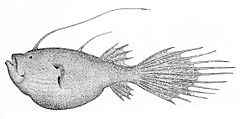- Ceratiidae
-
This article is about the deep-sea fish. For other uses, see Sea devil (disambiguation).
Sea devils 
Krøyer's deep sea angler fish, Ceratias holboelli Scientific classification Kingdom: Animalia Phylum: Chordata Class: Actinopterygii Order: Lophiiformes Family: Ceratiidae Genera Ceratias
Cryptopsaras
See text for species.Sea devils are a family of deep-sea anglerfish otherwise known as Ceratiidae[1] from the Greek keras, "horn", referring to the bioluminescent lure that projects from the fishes' forehead.
They are among the most widespread of the anglerfishes, found in all oceans from the tropics to the Antarctic. They are large and elongate: females of the largest species, Krøyer's deep sea angler fish, Ceratias holboelli, reach 1.2 metres (3.9 ft) in length. Males, by contrast, are dwarfed, reaching 14 centimetres (5.5 in), and, like other anglerfishes, spend much of their lives attached to a female after a free-living adolescent stage in which they are very small - at most 1.3 centimetres (0.51 in) - and have sharp, beak-like, toothless jaws.[2] One or more males attach themselves parasitically and permanently to a female, eventually merging circulatory systems. As this genetic chimera matures the males grow large testicles while the rest of their body atrophies. Ceratioidea are the only creatures known to become Chimeras as a normal part of their life-cycle.
Genera and species
- Genus Ceratias
- Krøyer's deep sea angler fish, Ceratias holboelli Krøyer, 1845.
- Ceratias tentaculatus (Norman, 1930).
- Ceratias uranoscopus Murray, 1877.
- Genus Cryptopsaras
- Triplewart seadevil, Cryptopsaras couesii Gill, 1883.
References
- ^ Froese, Rainer, and Daniel Pauly, eds. (2006). "Ceratiidae" in FishBase. February 2006 version.
- ^ Theodore W. Pietsch. "Ceratiidae". Tree of Life. http://tolweb.org/Ceratiidae/22010. Retrieved 3 April 2006.

This order Lophiiformes (Anglerfish) related article is a stub. You can help Wikipedia by expanding it. - Genus Ceratias

